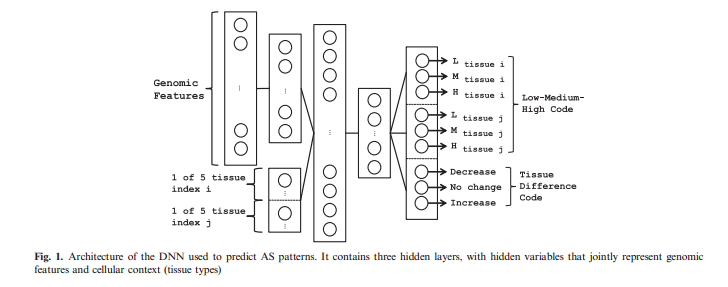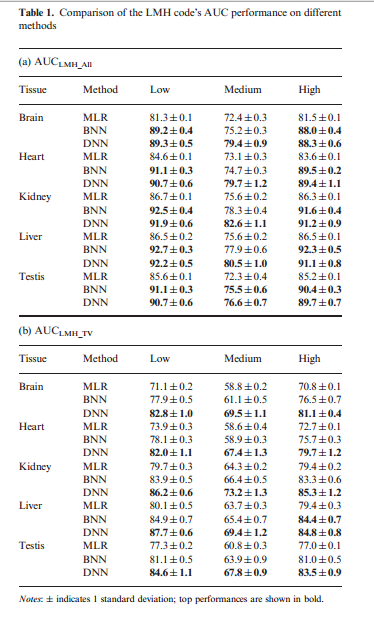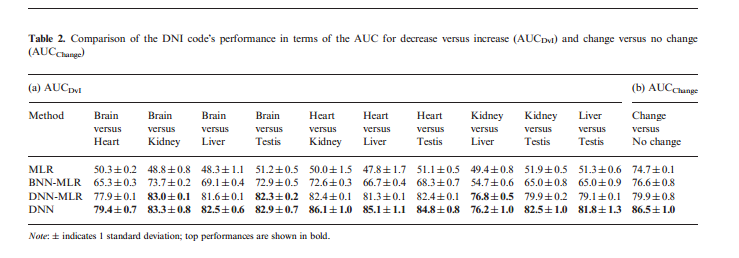deep Learning of the tissue-regulated splicing code
Introduction
Alternative splicing(AS) is a regulated process during gene expression that enables the same gene to give rise to splicing isoforms containing different combinations of exons, which leads to different protein products. Furthermore, AS is often tissue dependent. This paper mainly focus on performing Deep Neural Network (DNN) in predicting outcome of splicing, and compare the performance to formerly trained model Bayesian Neural Network<ref>https://www.cs.cmu.edu/afs/cs/academic/class/15782-f06/slides/bayesian.pdf</ref> (BNN), and Multinomial Logistic Regression<ref>https://en.wikipedia.org/wiki/Multinomial_logistic_regression</ref> (MLR).
A huge difference that the author imposed in DNN is that each tissue type are treated as an input; while in previous BNN, each tissue type was considered as a different output of the neural network. Moreover, in previous work, the splicing code infers the direction of change of the percentage of transcripts with an exon spliced in (PSI). Now, this paper perform absolute PSI prediction for each tissue individually without averaging across tissues, and also predict the difference PSI ([math]\displaystyle{ \Delta }[/math]PSI) between pairs of tissues. Apart from regular deep neural network, this model will train these two prediction tasks simultaneously.
Model
The dataset consists of 11019 mouse alternative exons profiled from RNA-Seq<ref>https://en.wikipedia.org/wiki/RNA-Seq</ref> Data. Five tissue types are available, including brain, heart, kidney, liver and testis.
The DNN is fully connected, with multiple layers of non-linearity consisting of hidden units. The mathematical expression of model is below:
- [math]\displaystyle{ {a_v}^l = f(\sum_{m}^{M^{l-1}}{\theta_{v,m}^{l}a_m^{l-1}}) }[/math], where a is the weighted sum of outputs from the previous layer. [math]\displaystyle{ \theta_{v,m}^{l} }[/math] is the weights between layers.
::::::: [math]\displaystyle{ f_{RELU}(z)=max(0,z) }[/math], The RELU unit was used for all hidden units except for the first hidden layer, which uses TANH units.
::::::: [math]\displaystyle{ h_k=\frac{exp(\sum_m{\theta_{k,m}^{last}a_m^{last}})}{\sum_{k'}{exp(\sum_{m}{\theta_{k',m}^{last}a_m^{last}})}} }[/math], this is the softmax function of the last layer.
The cost function we want to minimize here during training is [math]\displaystyle{ E=-\sum_a\sum_{k=1}^{C}{y_{n,k}log(h{n,k})} }[/math], where [math]\displaystyle{ n }[/math] denotes the training example, and [math]\displaystyle{ k }[/math] indexes [math]\displaystyle{ C }[/math] classes.
The identity of two tissues are then appended to the vector of outputs of the first hidden layer, together forming the input into the second hidden layer. The identity is a 1-of-5 binary variables in this case. (Demonstrated in Fig.1) The first targets for training contains three classes, which labeled as low, medium, high (LMH code). The second task describes the [math]\displaystyle{ \Delta PSI }[/math] between two tissues for a particular exon. The three classes corresponds to this task is decreased inclusion, no change and increased inclusion (DNI code).Both the LMH and DNI codes are trained jointly, reusing the same hidden representations learned by the model. The DNN used backpropagation with dropout to train the data, and used different learning rates for two tasks.
Performance comparison
The performance of the model was assessed using the area under the Receiver-Operating Characteristic curve (AUC) metric. This paper compared three methods through the same baseline, DNN, BNN and MLR.
The result (LMH code) shows in the table below. Table 1a reports AUC for PSI predictions from the LMH code on all tissues; while 1b reports AUC evaluated on the subset of events that exhibit large tissue variability. From 1a, the performance of DNN in low and high categories are comparable with the BNN, but outperformed at the medium level. From 1b, DNN significantly outperformed BNN and MLR. In both comparison, MLR performed poorly.
Next, we look at how well the different methods can predict [math]\displaystyle{ \Delta PSI }[/math] (DNI code). DNN predicts LMH code and DNI code at the same time; while in BNN, the model can only predict LMH code. Thus, for a fair comparison. author used a MLR on the predicted outputs for each tissue pair from BNN and similarly trained MLR on the LMH outputs of the DNN. Table 2 shows that both DNN and DNN+MLR outperformed the BNN+MLR or MLR.
Why did DNN outperform?
1. The use of tissue types as an input freature, which stringently required the model's hidden representations be in a form that can be well-modulated by information specifying the different tissue types for splicing pattern prediction.
2. The model is described by thousands of hidden units and multiple layers of non-linearity. In contrast, BNN only has 30 hidden units, which may not be sufficient.
3. A hyperparameter search is performed to optimize the DNN.
4. The use of dropout, which contributed ~1-6% improvement in the LMH code for different tissues, and ~2-7% in the DNI code, compared with without dropout.
5. Training was biased toward the tissue-specific events (by construction of minibatches).
Conclusion
This work shows that DNN can also be used in a sparse biological dataset. Furthermore, the input features can be analyzed in terms of the predictions of the model to gain some insights into the inferred tissue-regulated splicing code. This architecture can easily be extended to the case of more data from different sources.
reference
<references />


